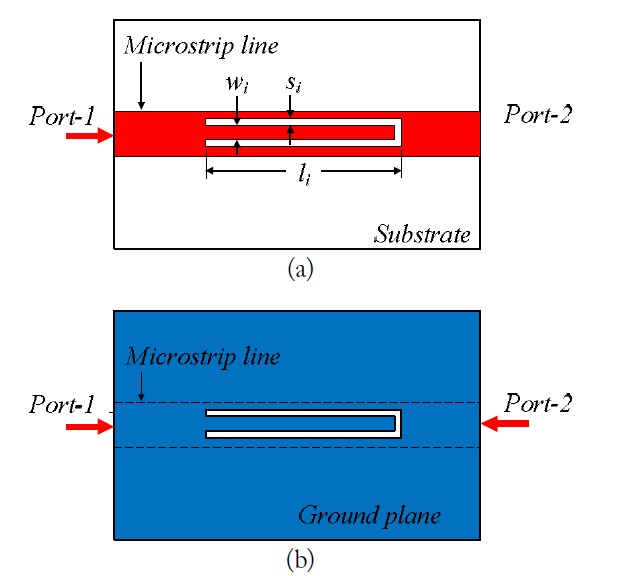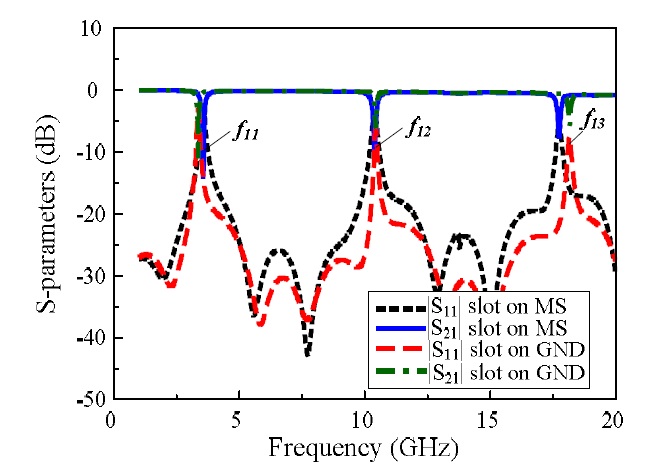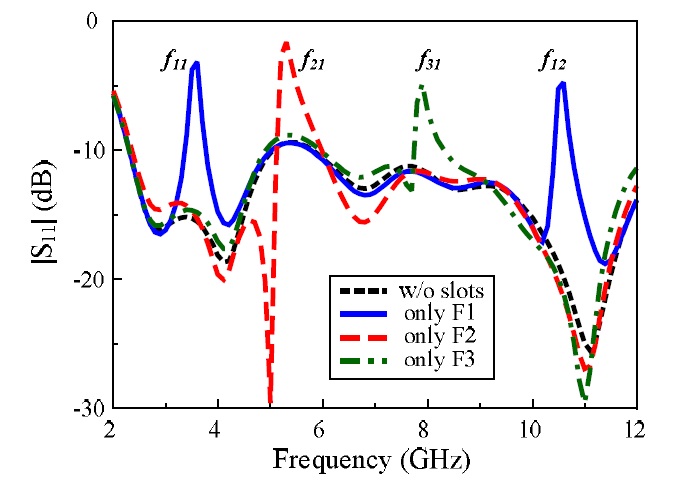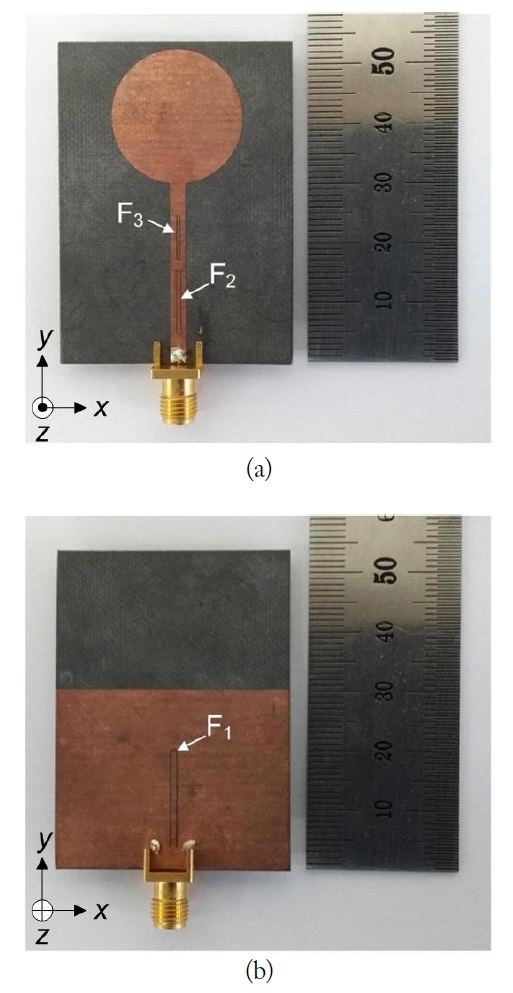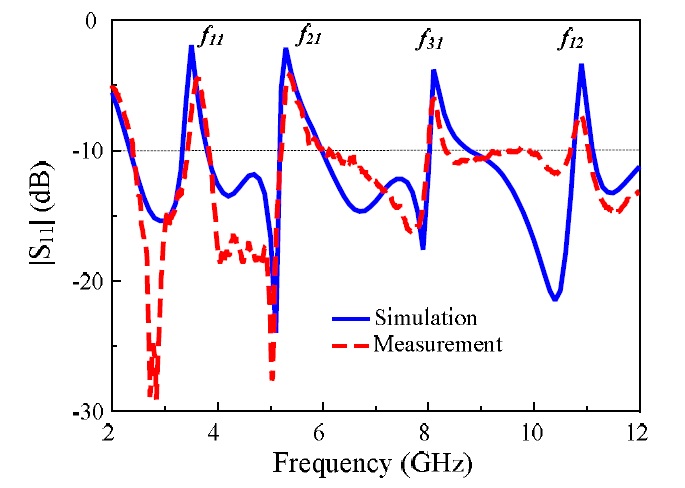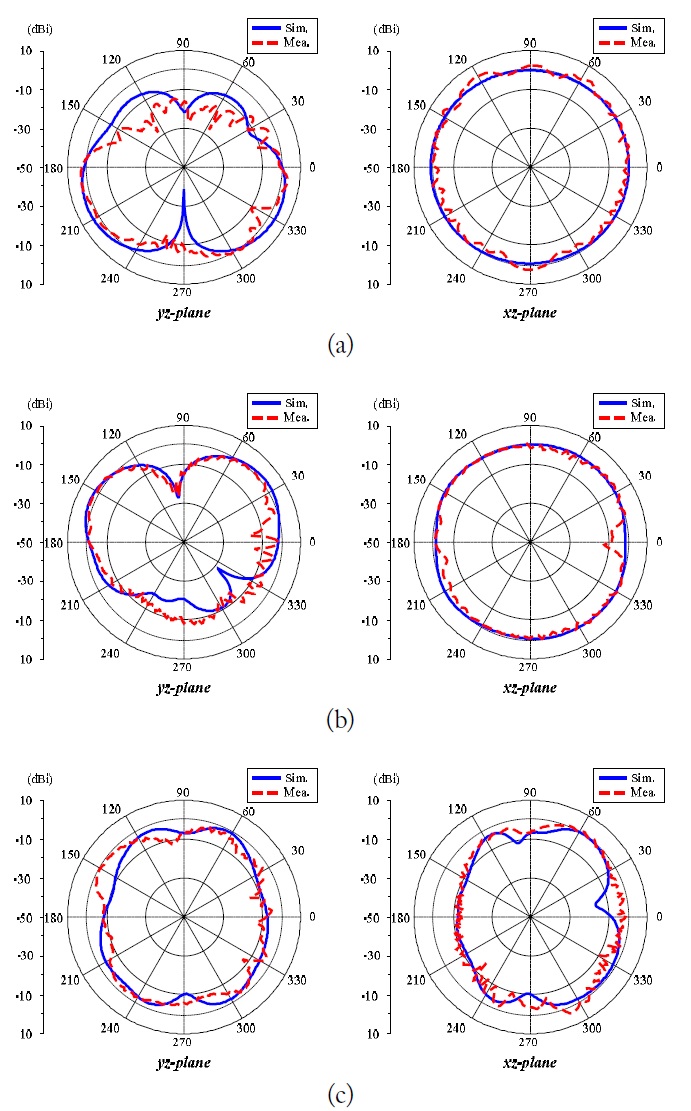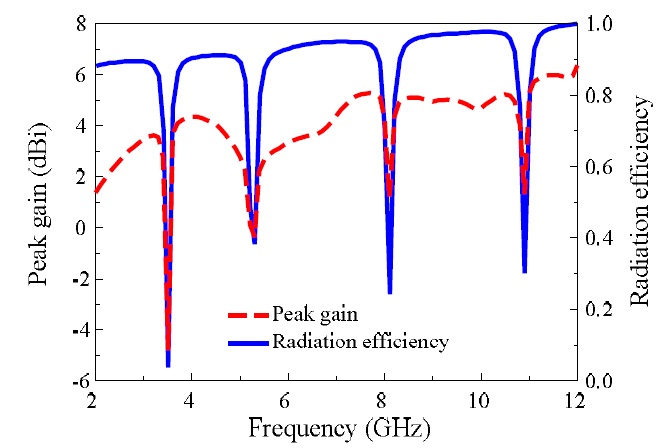



The Federal Communication Commission of the United States of America approved the utilization of the 3.1-10.6 GHz unlicensed band for commercial ultra-wideband (UWB) communication in 2002 [1]. Since then, many types of antennas have been developed for UWB applications [2-5]. Nevertheless, the UWB antennas face many challenges, including establishment of wideband impedance matching, radiation stability, compact size, and low manufacturing cost. Furthermore, owing to the overlap of the UWB band and extant narrow band applications, such as the worldwide interoperability for microwave access application (WiMAX: 3.3-3.7 GHz) band, the wireless local area network (WLAN: 5.15-5.825 GHz) band, and the International Telecommunication Union (ITU: 7.725-8.275 GHz) band, UWB antennas with the notched-band characteristic must avoid interference. A variety of methods have been presented to achieve the band notch characteristic in which a pair of slots is etched onto a radiating patch of a monopole antenna to provide good rejection in the 5-GHz WLAN band [6]. A CPW-fed monopole antenna [7] was presented with a slotted/added rectangle on the opposite side of the substrate to provide a band-notched function. Split ring resonators were etched onto the radiating patch of a UWB antenna for the band notches [8,9]. In most of these designs, notch functions were achieved by implementing slots on the radiating elements or ground plane of the antenna. However, this technique cannot be applied to antennas that lack a large area for implementing the slots, such as log-periodic, spiral, or Vivaldi antennas. Recently, other methods, such as utilizing the electromagnetic band-gap structures [10], asymmetric coupled-lines [11], and capacitively loaded loop resonators [12] have been employed in the feeding structure of the UWB antenna to obtain notched bands at the desired frequency. However, these techniques introduce an additional complexity of the feeding configuration.
This paper describes a multiband-notched UWB antenna with a simple primary radiating element of a printed circular monopole. The multiband notch characteristic is completely engineered in the feeding structure by using multiple bandstop filters, which consist of three folded-slots: one slot is etched onto the ground plane, and other two are etched onto the microstrip line. The slots are distinctly assigned for notches at the 3.5-GHz WiMAX, 5-GHz WLAN, and 8-GHz ITU bands. An ANSYS-Ansoft high-frequency structure simulator (HFSS) was used for simulations throughout this work.
Ⅱ. ANALYSIS OF BANDSTOP FILTERS WITH A FOLDED SLOT
Fig. 1(a) and (b) show the geometries of the bandstop filter with a folded-slot on the microstrip line and the ground plane. The microstrip line was designed on an RT/Duroid 5880 substrate (
Here,
Ⅲ. MULTIBAND-NOTCHED UWB ANTENNA DESIGN AND CHARACTERISTICS
Fig. 3 shows the geometry of the multiband-notched UWB antenna. The antenna was realized with a simple circular monopole built on a 54 × 40-mm RT/Duroid 5880 substrate (
The individual roles of each slot embedded in the feeding structure of the UWB antenna, and their simulated |S11|, are illustrated in Fig. 4. Without slots, the UWB antenna has |S11| < -10 dB from 2.4 GHz to 12 GHz, and no notched band exists. Two notches are present at 3.5 and 10.9 GHz with only the F1-slot, a notch at 5.3 GHz with only the F2-slot, and a notch at 8.1 GHz with only the F3-slot. The proposed antenna employs all three slots in the feeding structure for the multiband-notch.
[Table 1.] Optimized design parameters of folded-slots for multiple stopbands (unit in mm)

Optimized design parameters of folded-slots for multiple stopbands (unit in mm)
This multiband-notched UWB antenna was fabricated and measured for performance verification. The antenna was built on both sides of an RT/Duroid 5880 substrate with a copper thickness of 17 μm. A 50-Ohm SMA connector was used as a microstrip-to-coaxial line transition (not included in the simulation) in the fabricated sample. A photograph of the fabricated antenna is shown in Fig. 5. A comparison between the simulated and measured |S11| of the UWB antenna is shown in Fig. 6. Agreement between the simulation and the measurement is observed. Both results yielded impedance matching bandwidth covering the UWB band (3.1-10.6 GHz) for |S11| < -10 dB and three notched bands at 3.5-GHz WiMAX, 5-GHz WLAN, and 8-GHz ITU. Additionally, the higher notched band appeared at 10.9 GHz, which is the second stopband of the F1 slot. Fig. 7 shows the radiation patterns of the multiband-notched UWB antenna in the E- and H-planes at 4.5, 7.0, and 9.5 GHz. The radiation patterns are omnidirectional at all checked frequencies, as with a conventional monopole antenna. The HFSS-predicted peak gain and radiation efficiency values are shown in Fig. 8 as a function of the frequency. As designed, a significant drop in these values is observed within the notched bands. Additionally, the antenna yielded stable radiation with a peak gain of approximately 4 dBi and a radiation efficiency of greater than 90% within the bandwidth of interest.
A UWB antenna has been introduced that has a multiband-notched characteristic at the 3.5-GHz WiMAX, 5-GHz WLAN, and 8-GHz ITU bands. Implementation of folded slots in the feeding structure achieves a notch characteristic without adding additional complexity to the antenna. This technique can also be widely applied to the feeding structure of other types of UWB antennas, such as logperiodic, Vivaldi, and spiral antennas.
